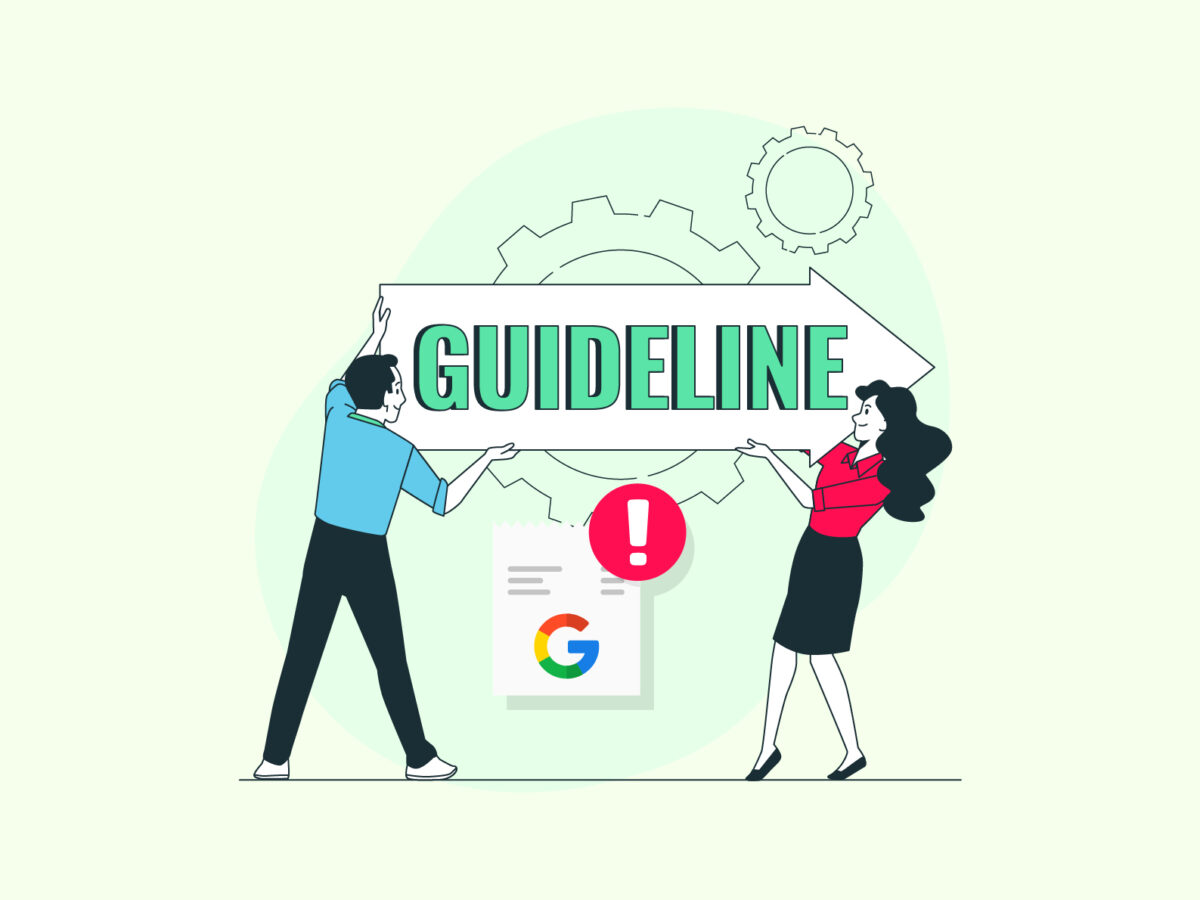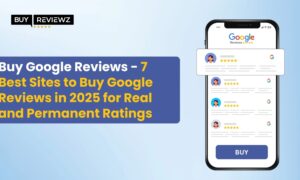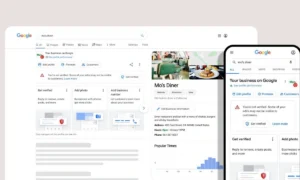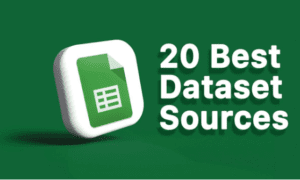Nobody wants to wake up to find their website has vanished from Google’s search results. Yet thousands of businesses face this nightmare every year when Google penalties strike. The good news? You can protect your site by understanding what triggers these penalties and taking proactive steps to avoid them.
Highlights
- Understanding Google penalties – manual vs. algorithmic penalties and their impact
- The big penalty triggers – low-quality content, sketchy links, technical disasters, and keyword stuffing
- Building your prevention strategy – content quality control, link profile management, and technical SEO maintenance
- Recovery strategies – what to do when penalties hit and how to bounce back
- Staying ahead of algorithm changes – keeping up with Google’s updates and protecting your rankings • Your action plan – practical steps to implement penalty-proof SEO today
Understanding Google Penalties
Google penalties come in two flavors: manual and algorithmic. Manual penalties happen when Google’s human reviewers find your site violating their guidelines and take direct action. Algorithmic penalties are automatic – they kick in when Google’s systems detect problematic patterns during regular crawls and updates.
The impact hits hard either way. Your rankings can drop overnight, organic traffic can disappear, and revenue can plummet. Some sites never recover from severe penalties, which is why prevention beats cure every single time.
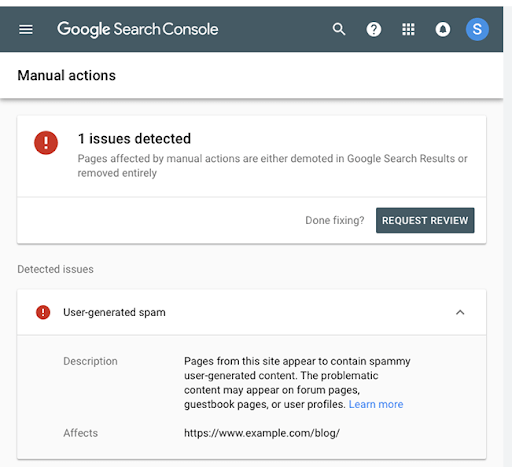
Manual penalties:
If you’re a verified owner of a domain in Search Console you’ll get an email. Another place to check is In Search Console > Security & Manual Actions. ‘No issues detected’ is good, otherwise you’ll see ‘Issues detected’ with a red exclamation mark implying breach of Google policies with a proportionate penalty.
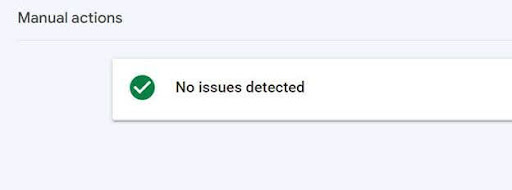
Algorithmic penalties:
Algorithmic penalties aren’t straightforward. Big, organic traffic drops are culprits of algorithmic penalties assuming no Manual Penalty is triggered in the Search Console.
You’ll have to exclude seasonal trends, extraordinary events, and downtime, and only after doing so, you’ll now that an algorithmic penalty was triggered.
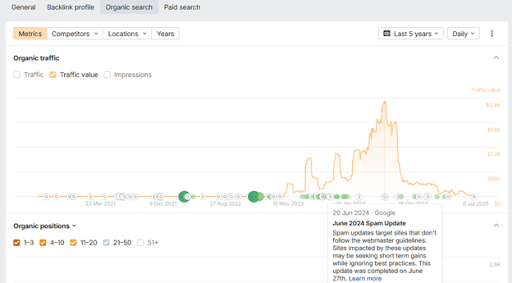
June 2024 Spam Update smashing down organic traffic for a website – algorithmic penalty
The Big Penalty Triggers You Need to Watch
Low-Quality Content
Google’s algorithms have gotten scary good at spotting thin, duplicate, or AI-generated content that adds no real value. They’re looking for content that genuinely helps users solve problems or find information. If your pages feel like they were created just to rank rather than to serve your audience, you’re walking into penalty territory.
Create content that passes the “so what?” test. Every page should answer a real question or solve a specific problem your audience faces. Skip the keyword stuffing and focus on being genuinely helpful.
An example of a keyword stuffed article:
“Buy running shoes online from our running shoes store! Our running shoes are the best running shoes for runners who need quality running shoes. We sell cheap running shoes, comfortable running shoes, and durable running shoes. Our running shoes collection includes men’s running shoes, women’s running shoes, and kids running shoes. Shop running shoes today and get free shipping on all running shoes orders. These running shoes are perfect running shoes for marathon running shoes enthusiasts. Order your running shoes now and experience why our running shoes are the top-rated running shoes in the running shoes market.”
Sketchy Link Building
Bad backlinks remain one of the fastest ways to trigger a penalty. Google can spot unnatural link patterns from miles away – think paid links, link farms, excessive reciprocal linking, or links from completely irrelevant sites. They’re particularly harsh on sites that try to manipulate PageRank through artificial link schemes.
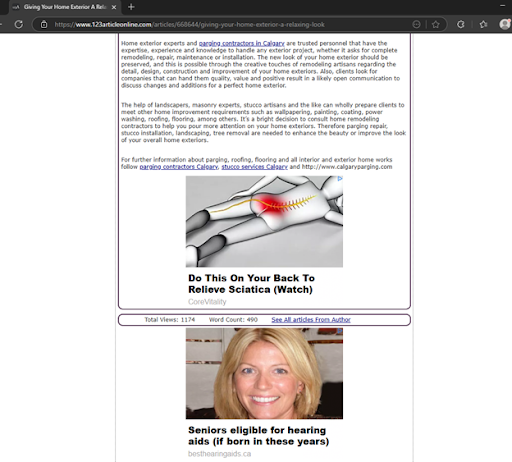
Blog post showing artificial link building, credits: Visibility Drip
Focus on earning links naturally through great content, genuine relationships, and providing real value to other sites in your industry. Quality beats quantity every time.
Technical SEO Disasters
Cloaking, hidden text, sneaky redirects, and other technical tricks that try to show search engines different content than users see will get you penalized fast. Google’s crawlers are sophisticated enough to catch these tactics, and the penalties are severe.
Keep your technical SEO clean and transparent. What users see should match exactly what search engines crawl.
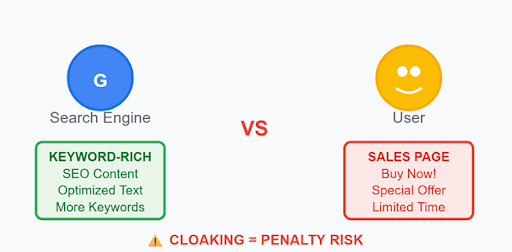
Keyword Stuffing and Over-Optimization
Cramming your target keywords into every sentence, using exact-match keywords unnaturally, or building pages that read like robot-generated content triggers Google’s over-optimization filters. Modern SEO requires finesse, not force.
Write naturally for humans first. Use keywords where they make sense contextually, and focus on semantic variations rather than exact matches.
Building Your Penalty Prevention Strategy
Content Quality Control
Audit your existing content regularly. Look for pages with thin content, duplicate information, or topics that don’t serve your audience’s needs. Either improve these pages significantly or remove them entirely. Every page on your site should have a clear purpose and provide genuine value.
Set up content guidelines for your team that prioritize user experience over search engine manipulation. Create comprehensive, well-researched content that establishes your expertise and builds trust with your audience.
Clean Link Profile Management
Monitor your backlink profile monthly using tools like Google Search Console, Ahrefs, or SEMrush. Look for suspicious patterns like sudden spikes in low-quality links, links from unrelated industries, or links with over-optimized anchor text.
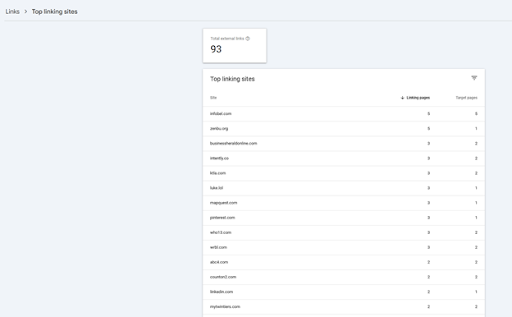
Referring domain data from Search Console
When you spot potentially harmful links, reach out to the linking sites to request removal. Document these efforts carefully – you’ll need this information if you ever need to submit a disavow file to Google.
Technical SEO Maintenance
Run regular technical audits to catch issues before they become penalty triggers. Check for duplicate content, broken internal links, slow page speeds, and mobile usability problems. Use Google’s own tools like PageSpeed Insights and Mobile-Friendly Test to identify areas for improvement.
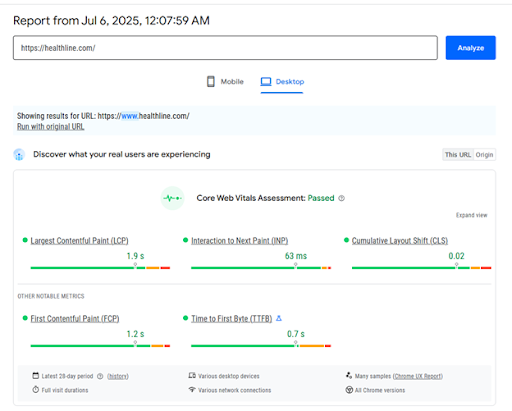
Page Speed Insights results for Healthline
Keep your site architecture clean and logical. Users and search engines should be able to navigate your site easily and understand the relationship between different pages.
Recovery Strategies When Things Go Wrong
Even with the best prevention efforts, penalties can sometimes happen. The key is responding quickly and systematically. Start by identifying the penalty type through Google Search Console notifications and traffic pattern analysis.
For manual penalties, you’ll need to fix the underlying issues and submit a reconsideration request with detailed documentation of your remediation efforts. For algorithmic penalties, focus on comprehensive site improvements and wait for the next algorithm update to see recovery.
This process can be complex and time-consuming but it still works, especially when dealing with link-related penalties. Many businesses have found success working with SEO specialists who understand the intricacies of penalty recovery. For example, this business successfully recovered from a Google algorithmic penalty by properly implementing a disavow file strategy and comprehensive link cleanup process.
Staying Ahead of Algorithm Changes
Google updates its algorithms constantly, with major updates happening several times per year. Stay informed about these changes through official Google communications, SEO industry news(searchenginejournal.com comes recommended), and webmaster forums. When significant updates roll out, monitor your traffic and rankings closely for any unusual patterns.
The best defense against algorithm changes is following Google’s fundamental guidelines consistently. Sites that focus on user experience, quality content, and ethical SEO practices typically weather algorithm updates much better than those using manipulative tactics.
Daily Audits to Stay on Top of What’s Going on With Your Website
Start with a comprehensive site audit to identify any existing penalty risks. Fix technical issues, improve thin content, and clean up questionable backlinks. Implement regular monitoring processes to catch problems early, and create content guidelines that prioritize user value over search engine manipulation. It does work in the long term.

